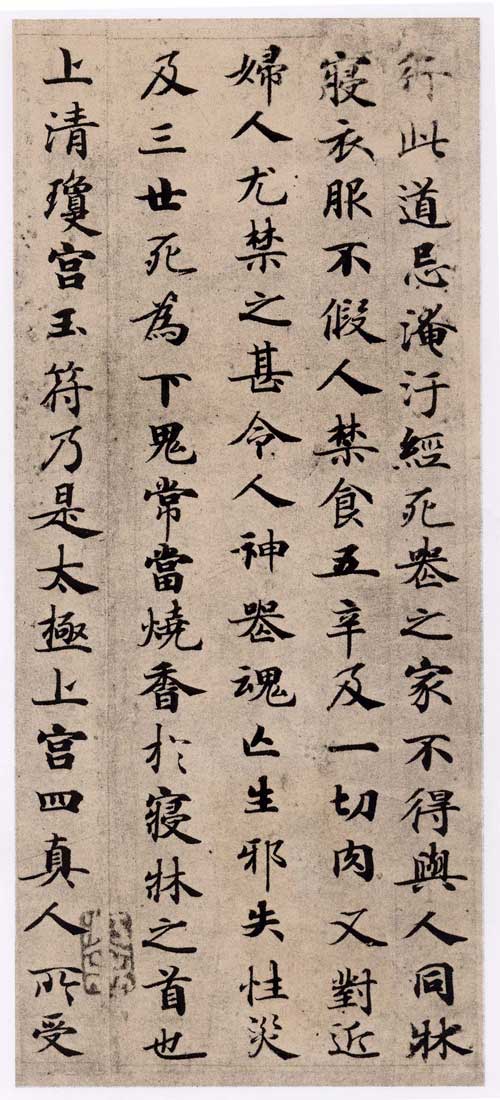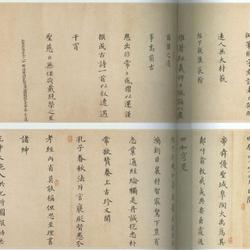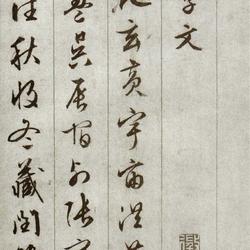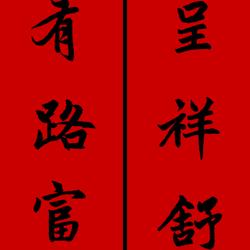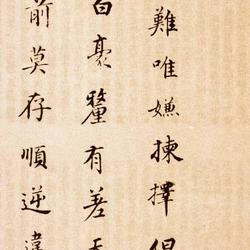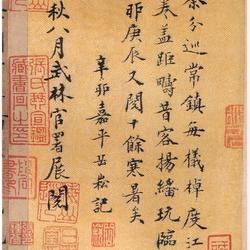"Lingfei Liujia Jing" is a Taoist scripture. In the late Ming Dynasty, a fine manuscript from the Kaiyuan period of the Tang Dynasty was discovered. Its handwriting style is very similar to that of the brick pagoda inscriptions, but the sharp ink color is far beyond the stone carvings. Comparable. At that time, it came into the hands of Dong Qichang and contained his inscriptions and postscripts. A collection of "Bohai Zhen Zhen" engraved by Chen Shi of Haining was borrowed from the Dong family and copied into stone. The two families seem to have mortgage procedures. Later, the Dong family redeemed it and resold it, causing many disputes back and forth. When the entire volume of "Bohai" was copied, twelve lines fell off. When Dong redeemed it, Chen withheld forty-three lines. Judging from the situation of the pages withheld, the twelve lines may have been withheld by Dong during the first mortgage, and later combined and divided. Now only the forty-three lines withheld by Chen remain, and the rest have been I don’t know if it’s been lost.
The calligraphy of "Ling Fei" itself is one of the best among Tang Dynasty scriptures. Compared with the many Tang Dynasty scriptures produced in Dunhuang, there are not many that are as exquisite as "Ling Fei". In the imperial examination standards of the Qing Dynasty, the quality of calligraphy was almost as important as the quality of writing, so it became an excellent model for literati to learn regular script. As a result, the initial expansion of "Bohai" became a rare treasure. The original stones were gradually damaged due to beating and rubbing, and various reprints appeared. The reprinted "Ci Huitang Tie" has smooth strokes and fake Zhao Mengfan postscripts. It became the leader of reprints in the mid-Qing Dynasty, but in fact it is a poor copy and is even further away from the original appearance of "Bohai" .
During the Jiaqing period, Xie Gongming of Jiashan received the forty-three lines drawn by Chen and engraved them into "Wangyunlou Tie". The engraving method is different from that of "Bohai". Not only do you pay attention to the pauses at the rise and fall of the strokes, but they are also slightly fatter than the "Bohai" version. Anyone who has read the Dunhuang scriptures will easily feel that "Wangyun" may be more realistic, while "Bohai" may be somewhat distorted.
These forty-three lines belonged to the Weng family of Changshu in the late Qing Dynasty. From the photocopied "Pinglu Congong Manuscript" written by Wen Gong and Tonghe, we learned that they had been in the Weng family for three generations. Mr. Wange, the great-great-grandson of Wen Gong, came to Beijing a few years ago and happily reminisced about the friendship between generations. The first thing I asked about was these forty-three lines. Brother Wange graciously presented the photobook as a gift and also personally copied Chen's There are many inscriptions and several postscripts by Wen Gong. After seeing the true face of Lushan Mountain, I could really see the brushwork and ink techniques of the Tang Dynasty, and I realized that both "Bohai" and "Wangyun" were all out of shape. In particular, the characteristics of flying ink colors are far beyond what stone rubbings can express. This time Mr. Wange gave it to "Yiyuan Duoying" for publication, so that the forty-three lines of "Ling Fei" can be seen in their true form, which is indeed a matter of great significance.
The great significance I am talking about is not only that the majority of calligraphy enthusiasts can see the famous authentic works of the Tang Dynasty, but what is even more significant is that in addition to "Ling Fei", Mr. Weng Wange also brought out the treasures collected in his family, plus What I have collected over the years and printed together to share with friends at home and abroad is a selfless act:
From the calligraphy theory of "Ling Fei", its elegant and ancient style, its stretched and reunited structure, and its simple and varied brushwork all fully express the characteristics of Tang calligraphy. In addition, there are two more important revelations for scholars:
First, I understand that it is difficult for any finely crafted stone carving to show the most important vitality in the ink. This can be like looking at the notes arranged on a musical score. Even if you remember it carefully, you have written down all the decorative notes besides the main melody. Might as well listen to a performance. Not only are the ink marks on "Ling Fei" different from the original ink marks, but all stone carvings are also different from the original ink marks. After reading the ink of "Ling Fei", you can suddenly feel enlightened. The value of this revelation goes beyond just appreciating "Ling Fei"? It helps scholars to understand the relationship between stone carvings and ink marks when studying all stone carvings. No longer will the rigid knife marks be regarded as the complete effect written by the hair cone.
Second, since "Ling Fei" was engraved on stone, it had a great influence on many calligraphers in the early Qing Dynasty. It can even be said that it directly or indirectly influenced the Qing Dynasty. Until Bao Shichen came out and vigorously advocated Beibei, the influence of Tang Bei School and "Lingfei" was relatively weakened. However, before the abolition of the imperial examination, this influence had not been completely replaced by Beibei in the field of examination papers. Here I would like to add a correction explanation: the Qing Dynasty Guange scroll absorbs an aspect of the "Ling Fei" edition, which does not weaken the status of "Ling Fei" in the true meaning of calligraphy. The emergence of the original work today can clear up the misunderstanding that "Ling Fei" and the pavilion are folded together.
In the mid-Qing Dynasty, a small amount of Tang Dynasty ink writing on scriptures gradually appeared, and calligraphers gradually paid more attention to this kind of ink writing. For example, Wang Wenzhi obtained the Vinaya Sutra and repeatedly talked about confirming its writing style. Prince Cheng and Wu Rongguang also repeatedly wrote postscripts and praised a volume of "Law of Good Views" that is divided into many sections. These sutra writing ink marks have also been copied in several series of posts. But their prestige is not as prominent as Lingfei's. What is the reason? Of course, the fact that "Bohai" has been spread for a long time and widely is a factor. However, after careful review of those several scriptures, their changes in style are indeed inferior to "Lingfei". Even today, if we compare the manuscripts produced in Dunhuang and left by the Heian Dynasty in Japan with "Ling Fei", "Ling Fei" can still be compared to that without being inferior easily. So these forty-three lines of outstanding works of art that can withstand many comparisons are printed today. I feel proud of the unsung hero calligrapher:
Nothing in this world is perfect. When reading these forty-three lines, you can’t help but regret not seeing the full text. But from another perspective, "Bohai" is not really a full text. It has no premise, and it is not known whether there is any text before the first line. The middle question is missing twelve lines, which has attracted less attention. If we look at these forty-three lines from the spirit of "compensating for the tripod with a penny", every word is true and true, and there is not a trace of knife marks or stones. It is far better than thousands of lines of carved words. The twelve missing lines of "Bohai" are the last twelve lines of the forty-three lines. It is a pleasure to read it together with the entire "Bohai".
As for Zhong Shaojing's calligraphy and other conjectures, it is actually a common problem among connoisseurs since ancient times. For calligraphy and painting without inscriptions, it is often necessary to assign an author to it. Some of them are signed outside the volume or designated in the postscript at the end of the volume. This is not enough. Damage to the original traces; some even add fake inscriptions to the scrolls, destroying cultural relics, which is not a serious matter. "Lingfei" has this theory since Yuan Jue of the Yuan Dynasty named him Zhong Shaojing, and it was inherited in the Ming and Qing Dynasties. So far, several authentic works of the Tang Dynasty have been seen by the world, so this speculation is no longer refuted. However, it is not surprising that the ancients have not seen many, so they have some speculations.
Appreciation of works: Xiaokai Lingfei Jing
